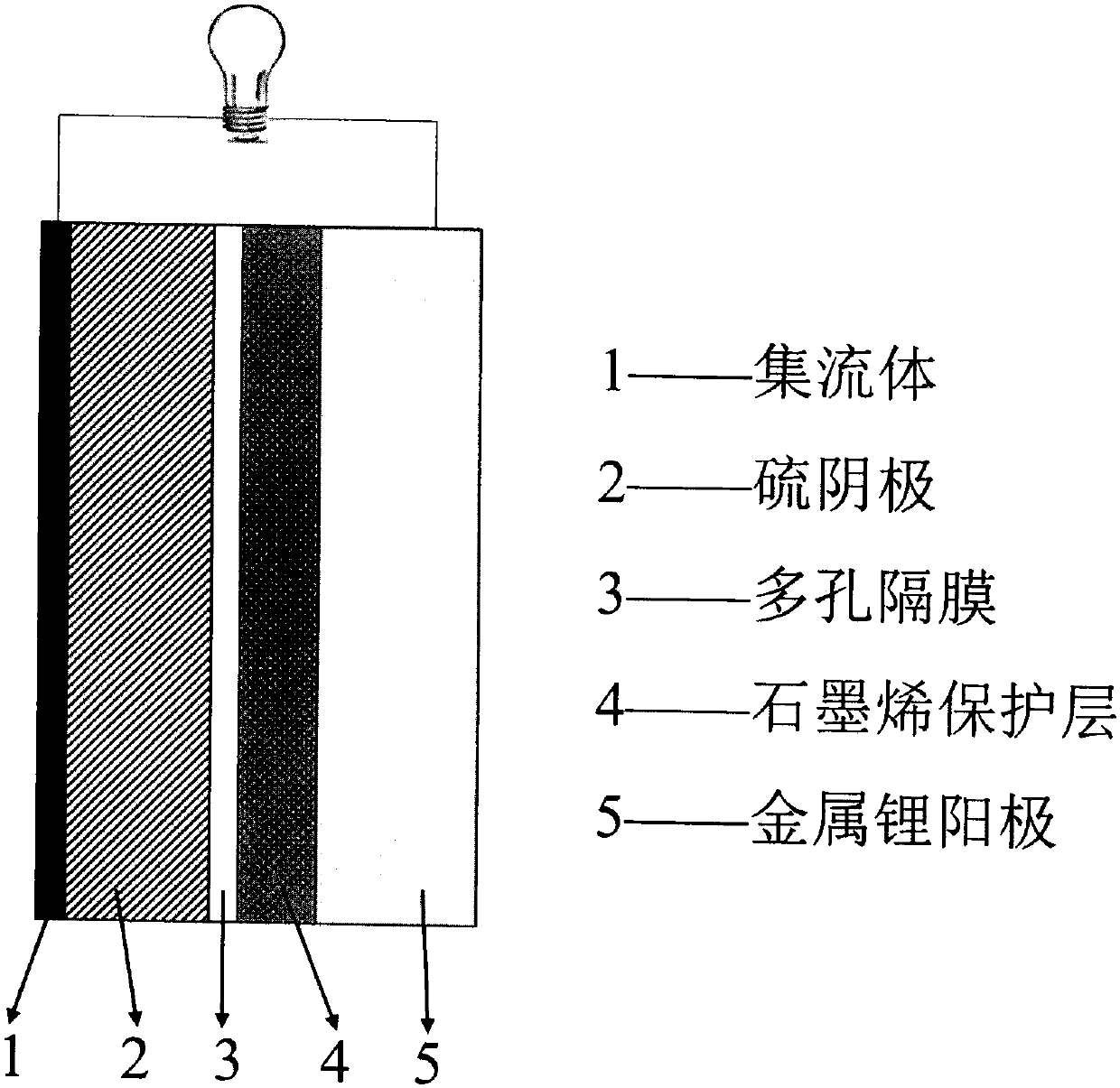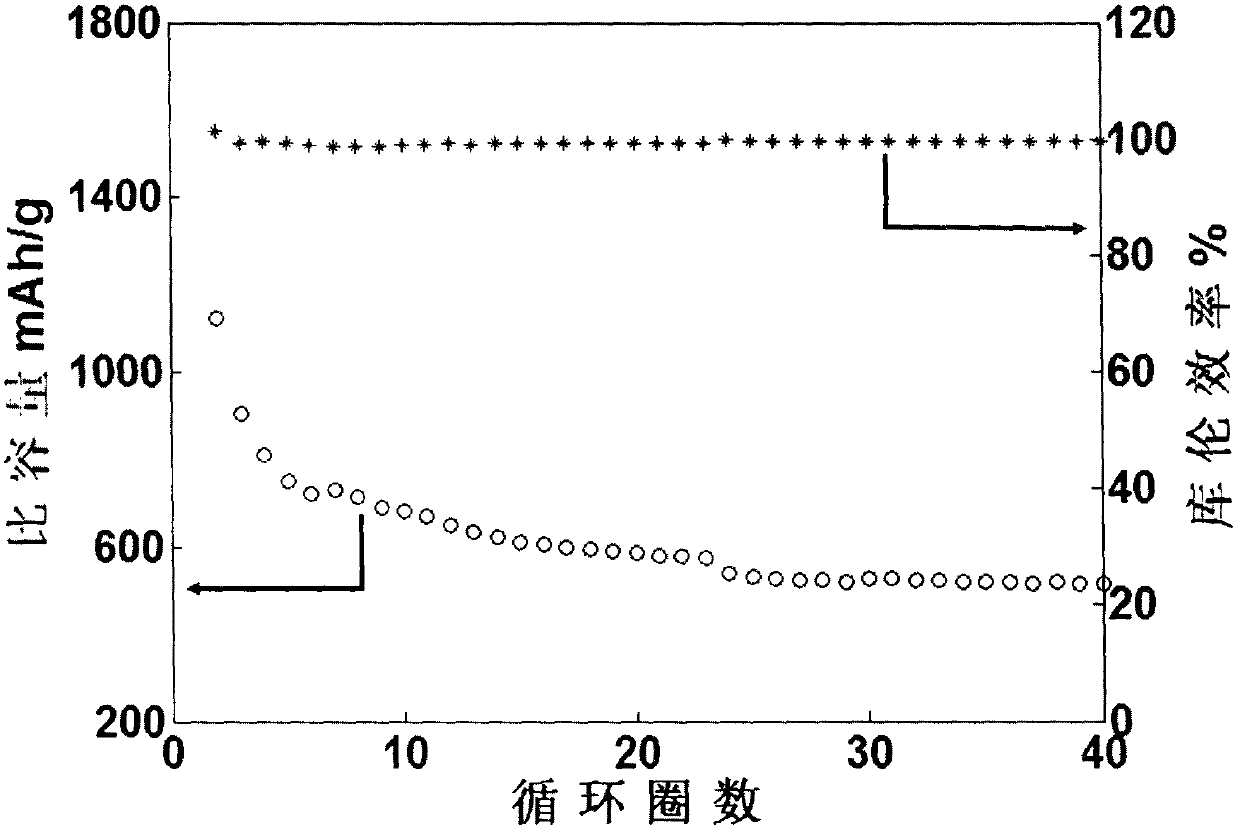Graphene-based protection layer on surface of metal lithium anode and corresponding lithium-sulfur battery
A lithium metal anode and alkenyl protective layer technology, which is applied in battery electrodes, secondary batteries, circuits, etc., can solve the problems of inability to suppress side reactions, fragility, and high brittleness, and achieve improved Coulombic efficiency and cycle stability. Sexuality, prevention of side effects, strong practicability
- Summary
- Abstract
- Description
- Claims
- Application Information
AI Technical Summary
Problems solved by technology
Method used
Image
Examples
Embodiment 1
[0030] Take 0.5g of chemically reduced graphene powder, 0.2g of nano-silicon powder, 0.2g of sulfur element, 0.1g of polyoxyethylene (average molecular weight 3 million) and disperse in 10ml of tetrahydrofuran to obtain a uniform slurry, and protect the above slurry in an inert atmosphere. Uniformly coated on the surface of the lithium metal anode, heat treatment at 50°C until the solvent is evaporated to dryness to obtain a graphene-based composite coating attached to the surface of the lithium anode, the thickness of the coating is 15 microns. Using the above-mentioned lithium anode with a graphene-based composite coating, assemble a battery with the sulfur-carbon cathode and diaphragm in Comparative Example 1, and add the electrolyte used in Comparative Example 1. The battery cycle data such as Figure 4As shown, the battery was cycled for 3 weeks at a rate of 0.05C, and the capacity was 1112mAh / g; after 20 weeks at a rate of 0.1C, the capacity was 857mAh / g, and the capacit...
Embodiment 2
[0032] Take 0.1g of heat-reduced graphene powder, 0.6g of sulfur elemental substance, 0.1g of stannous oxide powder, and 0.2g of polyvinylidene fluoride, and disperse them in 10ml of polyvinylpyrrolidone to obtain a uniform slurry, which is evenly coated on the comparative example 1 On the porous diaphragm used, the diaphragm coating was obtained after vacuum drying at 75°C, the thickness of the coating was 35 microns, and the diaphragm coating was rolled with lithium foil under the protection of an inert atmosphere to obtain a diaphragm-lithium composite anode, in which graphene-based The composite coating is between the separator and lithium anode. The above separator-lithium composite anode was assembled into a battery with the sulfur-carbon cathode described in Comparative Example 1, and the electrolyte used in Comparative Example 1 was added. The battery cycle data such as Figure 6 As shown, the battery was cycled at 0.05C rate for 12 weeks, and the capacity was 1381mAh...
Embodiment 3
[0034] Under the protection of an inert atmosphere, take 0.25g of heat-reduced graphene powder, 0.5g of phosphorus pentasulfide, 0.1g of stannous oxide powder, and 0.15g of polyvinylidene fluoride, and disperse them in 10ml of polyvinylpyrrolidone to obtain a uniform slurry. Coated on the porous diaphragm used in Comparative Example 1, dried at 75° C., and obtained a diaphragm coating after the solvent evaporated, and the thickness of the coating was 40 microns. Under the protection of an inert atmosphere, it is rolled with a lithium foil to obtain a separator-lithium composite anode, wherein the graphene-based composite coating is interposed between the separator and the lithium anode. The above separator-lithium composite anode was assembled into a battery with the sulfur-carbon cathode described in Comparative Example 1, and the electrolyte used in Comparative Example 1 was added. The battery cycle data such as Figure 6 As shown, the battery was cycled at 0.05C rate for 1...
PUM
| Property | Measurement | Unit |
|---|---|---|
| thickness | aaaaa | aaaaa |
| thickness | aaaaa | aaaaa |
| thickness | aaaaa | aaaaa |
Abstract
Description
Claims
Application Information
 Login to View More
Login to View More - R&D
- Intellectual Property
- Life Sciences
- Materials
- Tech Scout
- Unparalleled Data Quality
- Higher Quality Content
- 60% Fewer Hallucinations
Browse by: Latest US Patents, China's latest patents, Technical Efficacy Thesaurus, Application Domain, Technology Topic, Popular Technical Reports.
© 2025 PatSnap. All rights reserved.Legal|Privacy policy|Modern Slavery Act Transparency Statement|Sitemap|About US| Contact US: help@patsnap.com



